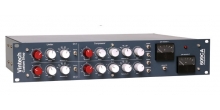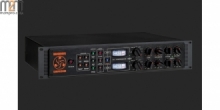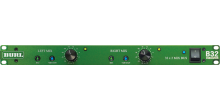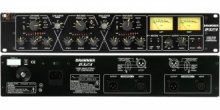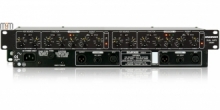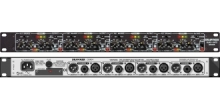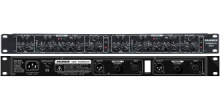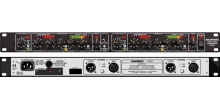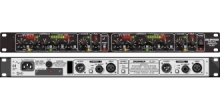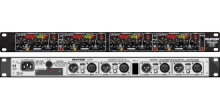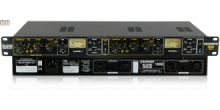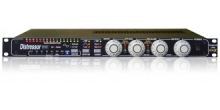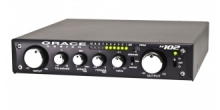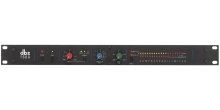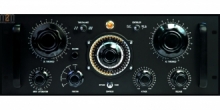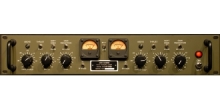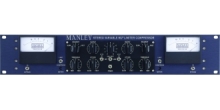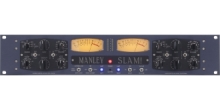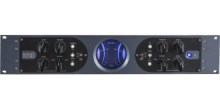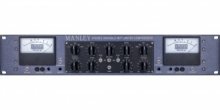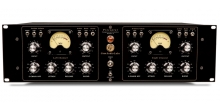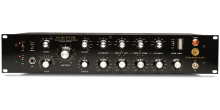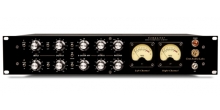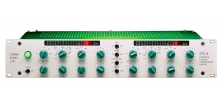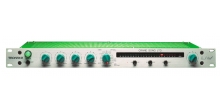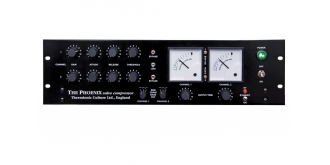 Agrandir l'image
Agrandir l'image
| Max. o/p level (MOL): | +19dB into 600Ohms +24dB into 10kOhms |
| Max gain: | 36dB. |
| THD (at no compression): | better than 0.06 % @ 100Hz & 1kHz |
| Noise, IEC weighted: | better than 100dB below MOL. |
| Input impedance: | 15kOhms. |
| Frequency response: | < 1dB variation over range of 12Hz to 56kHz. |
| Attack time: | 0.004s to 0.12s |
| Release time: | 0.04s to 2.4s |
| Output impedance: | 600Ohms |
Distortion will increase with compression, typically 0.2% & 0.25% at 1kHz & 100Hz with 8dB compression. Attack and release controls are somewhat interdependent, for instance a change of attack setting may affect the release time slightly. Therefore, no times are given on the front panel.
| VALVE COMPLEMENT (2 ea): |
| Input/Compression: PCC85 (equiv. 9AQ8) |
| Output: ECC81 (equiv. 12AT7, CV4024) |
| Side chain detector: EB91 (equiv. 6AL5, CV4025). |
THERC86C80
Nouveau
THERMIONIC CULTURE - The Phoenix SB

The Phoenix SB is now the standard production version of the Phoenix compressor. Alongside the now classic circuit design of the original Phoenix, it incorporates the side chain filter controls from the previous standard Phoenix SC model with the new addition of an HT standby switch.
The additional HT Standby switch allows the user to put the Phoenix into a low power standby mode that is designed to increase the life of the unit's valves and capacitors. When first switching on, or if the unit's not in use for a while, have the Standby on. Switch off Standby and it will instantly come back to full life.
We have also placed the meter zero controls on the front panel for much easier access. Both meters should read "0" when the Phoenix is off standby and not compressing. They can be adjusted easily by any user without harm to the unit.
The side chain filters can be used to cut the Phoenix's compression response to bass frequencies. The filter operates below either 150Hz or 300Hz on each channel and when stereo link is engaged the filters operate at the average of the two sides. This enables the user to choose from 5 filter frequencies when in stereo operation.
The Phoenix is well known for its smooth "soft knee" compression characteristic and excellent specifications. This means that it can be used as a compressor that will not harm your signal quality, whilst subtly controlling dynamic range. It is also possible to drive the unit harder to produce harmonic distortion and higher ratio compression if desired. Many users have found these features bring life to mixes or individual instruments, and control vocals, with a natural "warm" quality.
Contrary to the above, users have found that if the unit is operated in standby mode (it still passes audio) a "symmetrical" distortion occurs, not unlike that produced by overloading analogue tape. Perhaps this fact alongside an exaggerated compression curve lends to the Phoenix in standby mode another dimension.
- All valve signal path and side chain, point to point hand wired in England.
- Subtle control with "soft knee" compression, but more compression effects when pushed hard.
- Continuously variable attack, release and threshold controls.
- Stereo link for mix buss compression.
- Side chain filters to enable compression of all frequencies except bass.
- Flat frequency response over full audio range and beyond.
- Very low phase shift and harmonic distortion (unless pushed hard).
- Push-pull design gives a natural warm sound with high output level.
- Output trim controls for fine adjustment or lower level operation.
- Balanced ins and outs with custom made Sowter transformers.
- Bypass switch on each channel removes all electronics.
- Standby switch to prolong valve life.
- Distortion effects can be created with Standby on.
Features And Specs
| Max. o/p level (MOL): | +19dB into 600Ohms +24dB into 10kOhms |
| Max gain: | 36dB. |
| THD (at no compression): | better than 0.06 % @ 100Hz & 1kHz |
| Noise, IEC weighted: | better than 100dB below MOL. |
| Input impedance: | 15kOhms. |
| Frequency response: | < 1dB variation over range of 12Hz to 56kHz. |
| Attack time: | 0.004s to 0.12s |
| Release time: | 0.04s to 2.4s |
| Output impedance: | 600Ohms |
Distortion will increase with compression, typically 0.2% & 0.25% at 1kHz & 100Hz with 8dB compression. Attack and release controls are somewhat interdependent, for instance a change of attack setting may affect the release time slightly. Therefore, no times are given on the front panel.
| VALVE COMPLEMENT (2 ea): |
| Input/Compression: PCC85 (equiv. 9AQ8) |
| Output: ECC81 (equiv. 12AT7, CV4024) |
| Side chain detector: EB91 (equiv. 6AL5, CV4025). |




